Building EliteSaaS
The SaaS Template That Markets Itself—Complete with AI-Powered Content Generation
The Problem: SaaS Templates Stop at the Foundation
Every developer building a SaaS product faces the same tedious setup:
- Authentication system with social logins, password reset, email verification
- Subscription billing with Stripe—pricing tiers, trials, usage tracking, webhooks
- Team management with role-based access control and invitations
- Email infrastructure for transactional flows and marketing campaigns
- Admin dashboard with user management and analytics
- Content management system for blogging and SEO
- Social media integrations for growth and engagement
- Marketing automation and launch preparation
Most SaaS templates give you the first 3-4 items. Then you're on your own for marketing, content, and growth. This means spending 8-10 weeks building infrastructure before you can even validate your product idea.
I needed more than just a starter template. I needed a complete business growth system.
The Vision: A Template That Writes Your Marketing
I set out to build EliteSaaS: not just another Next.js template, but a complete SaaS platform with AI-powered marketing tools built in. The breakthrough insight:
Use the template's own AI tools to market the template itself.
The template becomes a proof-of-concept where its success demonstrates the effectiveness of its included marketing tools. Every blog post, social media campaign, and Product Hunt launch—all generated by the template's AI features.
Turborepo Monorepo
Organized workspace with shared packages (UI, types, Stripe utilities, teams, query) for clean architecture and code reuse. Smart caching reduces builds from minutes to seconds.
Complete Subscription System
Freemium or paid-only models, monthly/annual/lifetime pricing, 14-day trials, real-time webhook syncing, and automatic enforcement at route level.
AI-Powered Marketing
One-click generation of complete blog articles plus platform-specific social posts for LinkedIn, Twitter, Reddit, and Hacker News. SaaS-optimized prompts included.
Product Hunt Automation
AI-generated launch kits with listing content, social campaigns, email templates, FAQs, and timeline—all from your existing blog and app metadata.
The Tech Stack: Modern, Production-Grade, Scalable
Next.js 15 + React 19 + TypeScript
App Router with React Server Components reduces client bundle size and improves performance. TypeScript strict mode catches errors at compile time. Vercel's edge runtime provides global low-latency responses.
Turborepo Monorepo Architecture
Structured workspace with apps/web for the main application and packages/ for shared code—18+ shadcn/ui components in @elite-saas/ui, centralized types in @elite-saas/types, Stripe utilities in @elite-saas/stripe. Smart caching delivers 148ms cached builds.
Supabase (Auth + Database + Real-time)
PostgreSQL with Row Level Security enforces data isolation. Supabase Auth handles social logins, password reset, and email verification. Real-time subscriptions power live updates without polling. Migrations track schema changes in version control.
Stripe Subscription Infrastructure
Real-time webhook processing with service role database access syncs subscription status automatically. Configurable business models support freemium or paid-only. Monthly, annual (17% discount), and lifetime pricing with trial management and enforcement.
Vercel AI SDK (OpenAI, Anthropic, Google)
Multi-provider AI support for content generation. SaaS-optimized prompts for blog posts, social media campaigns, Product Hunt launches, and feature announcements. Streaming responses provide real-time feedback during generation.
Tailwind CSS 4 + shadcn/ui
CSS-first configuration with semantic design tokens. Dark mode support throughout. Accessible components built on Radix UI primitives. Responsive, mobile-first design patterns.
The Architecture: Monorepo + Service Layers + AI Integration
The monorepo structure provides clean separation of concerns:
Package Organization
- @elite-saas/ui: 18+ shadcn/ui components with Tailwind CSS v4 processing. Shared across the entire application with consistent styling.
- @elite-saas/types: Centralized TypeScript definitions for app, database, subscription, and Stripe types. Single source of truth.
- @elite-saas/stripe: Subscription configuration, client utilities, server-side operations, and pricing management. Clean abstraction over Stripe API.
- @elite-saas/teams: Complete team management system with invitations, role-based access, and member operations.
- @elite-saas/query: Optimized TanStack Query configuration with caching and real-time updates.
Subscription Enforcement Pattern
Every protected route checks subscription status via middleware:
// Route-level protection
export async function middleware(request: NextRequest) {
const user = await getUser();
const subscription = await getSubscription(user.id);
if (!subscription.active && requiresSubscription(request.path)) {
return redirect('/pricing');
}
return next();
}Dashboard UI displays subscription status with upgrade banners. Background webhooks sync Stripe events to database in real-time. No manual configuration needed—subscription states flow automatically.
AI Content Generation Pipeline
The AI system combines multiple data sources for context-aware generation:
- Load blog posts and app metadata (product name, description, features, pricing)
- Analyze brand voice from existing content using AI embeddings
- Generate platform-specific content (LinkedIn: detailed, Twitter: concise, Reddit: technical)
- Store in content library with status tracking (draft, approved, published)
- One-click publish to blog CMS or social platforms via API integrations
This pipeline reduces content creation time from 4+ hours to 10 minutes. The AI maintains consistency while adapting to each platform's constraints and audience.
The Product Hunt Launch Generator: AI-Powered Go-to-Market
Launching on Product Hunt requires dozens of assets—listing copy, social posts, email campaigns, FAQs, blog content. The AI Launch Generator automates the entire process:
The 4-Step Workflow
- Context Review: System analyzes existing blog posts, app configuration, social media history, and brand voice. Displays readiness checklist with completion status.
- Launch Parameters: Configure timing (12:01 AM PST recommended), target market, key features, launch goals, tone preferences, and competitor analysis.
- Generate Content: AI creates complete launch kit—Product Hunt listing (title, tagline, description, maker comment), 8 social posts, 3 email campaigns, blog post, press release, 8 FAQs.
- Review & Export: Preview all generated content with tabs for each asset type. Export as PDF, Markdown, JSON, or download individual assets.
What Gets Generated
Product Hunt Listing
- • 3 title options optimized for click-through
- • 3 tagline variations (60 chars max)
- • Short description (200 chars)
- • Detailed maker comment with markdown
Marketing Campaign
- • 8 social posts (Twitter, LinkedIn, Reddit)
- • 3 email campaigns (teaser, launch, follow-up)
- • Blog post announcing launch
- • Press release with boilerplate
Supporting Content
- • 8 FAQs addressing common objections
- • 12-task launch day timeline
- • Engagement response templates
- • Post-launch retrospective guide
Export Options
- • Complete PDF launch kit
- • Individual markdown files
- • JSON for programmatic access
- • Direct publish to blog CMS
The generator turns weeks of launch preparation into one afternoon. Every asset is brand-consistent, platform-optimized, and ready to deploy.
Team Management: Collaboration Without the Complexity
SaaS products need team collaboration, not just individual accounts. The team system provides:
- Team Creation: Users create teams with custom names and settings. One team per subscription tier.
- Member Invitations: Email-based invitations with token security. Resend functionality for expired invites.
- Role-Based Access: Owner (full control), Admin (manage members), Member (read-only). Permissions enforced at API and UI layers.
- Activity Logging: Complete audit trail for compliance and security. Track invitations, role changes, member removals.
- Real-time Updates: TanStack Query provides optimistic UI updates and automatic cache invalidation.
The team dashboard displays all members with status, role badges, and management actions. Responsive design works on mobile and desktop.
Inside EliteSaaS: A Visual Tour
Card-Based Admin Toolbox
System administration home organized by feature categories—Marketing & Growth, AI & Content Tools, and System Management. Each tool card provides clear descriptions and direct access to specialized workflows.
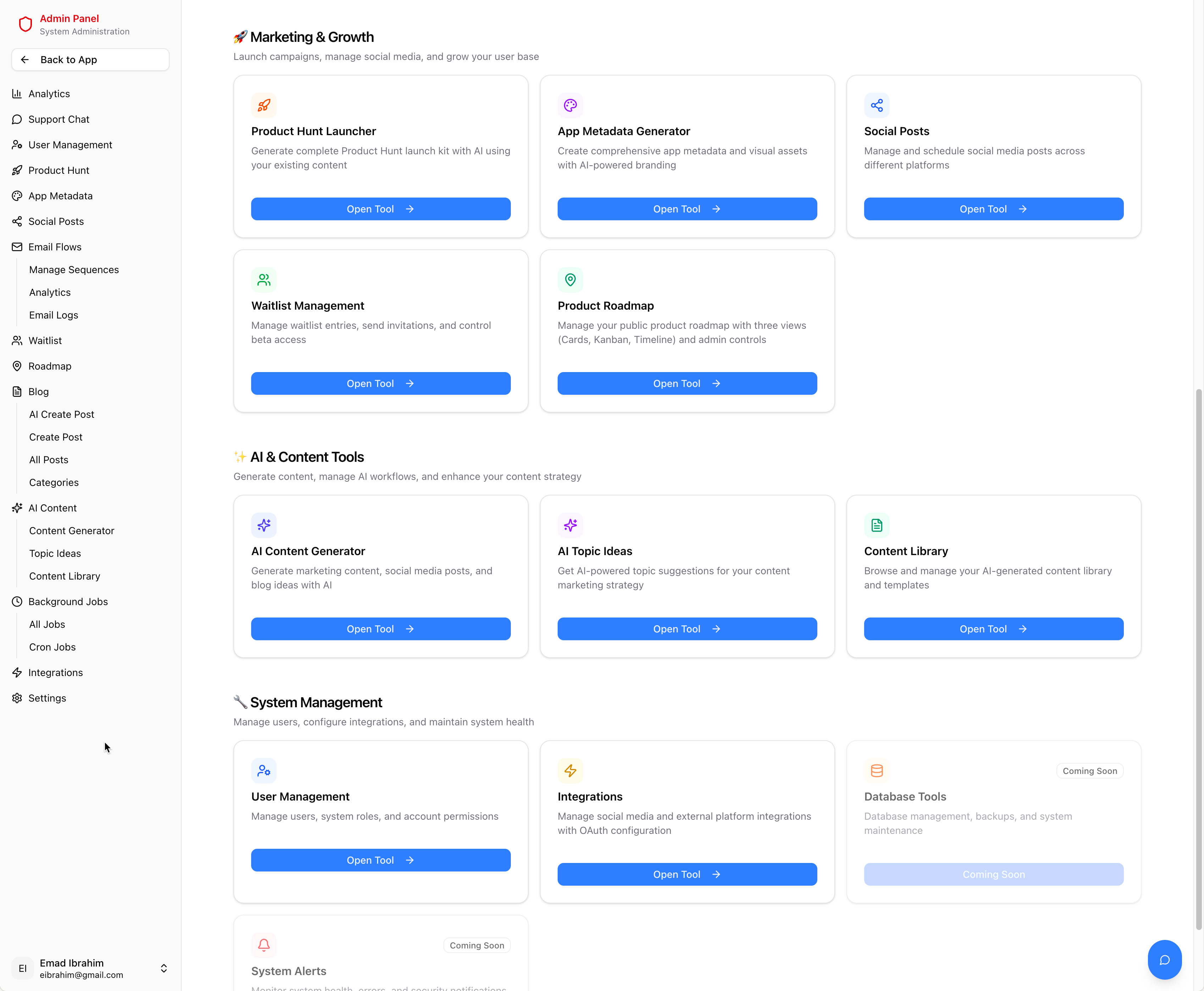
AI-Powered Product Hunt Launch Generator
Generate complete launch kits with listing content, social campaigns, email templates, FAQs, and timeline—all from your existing blog and app metadata. Includes launch strategy tips and tracks generation history.
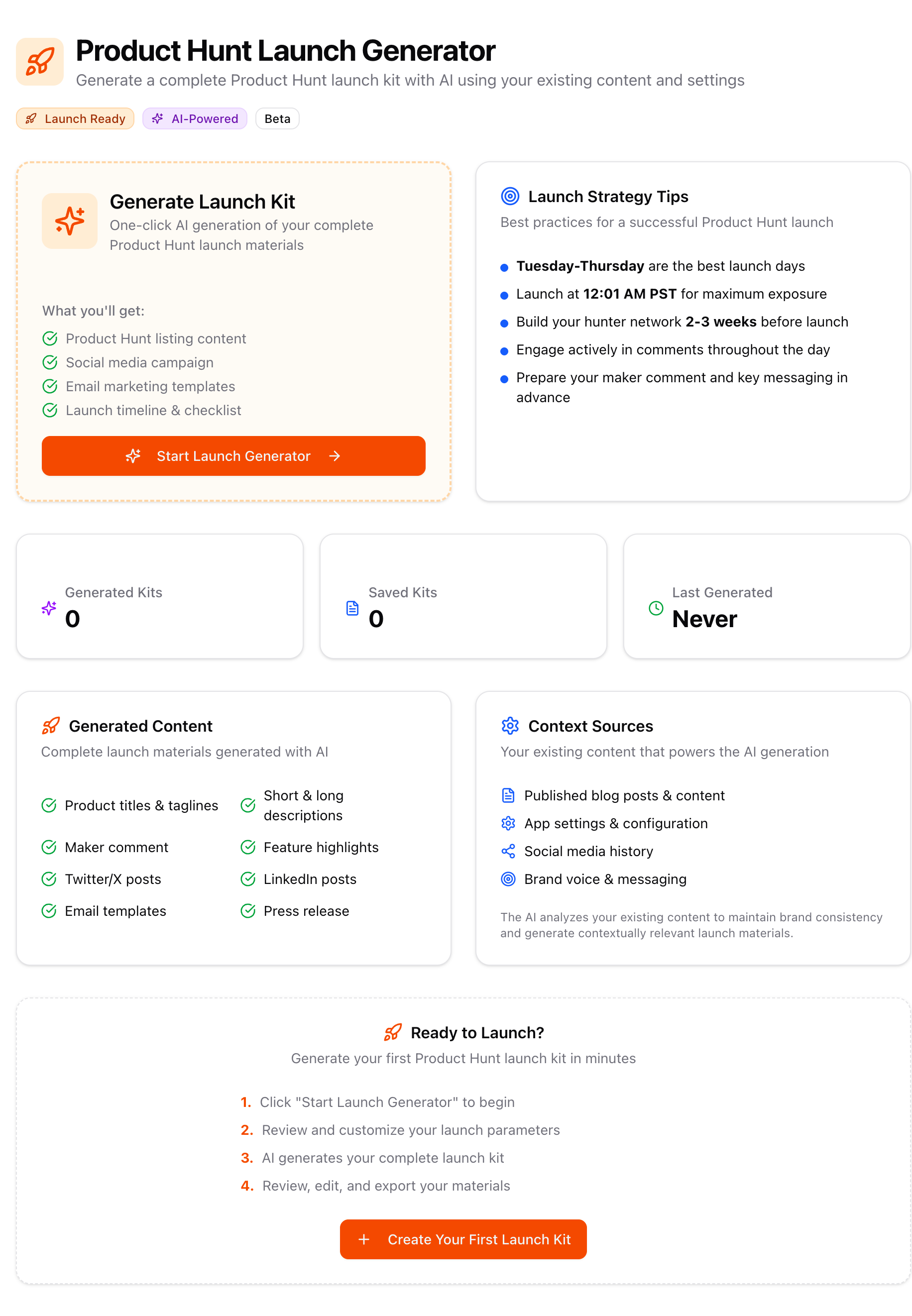
Intelligent Context Review
AI analyzes blog content, app configuration, social history, and brand voice. Displays readiness checklist with completion status before generating launch materials.
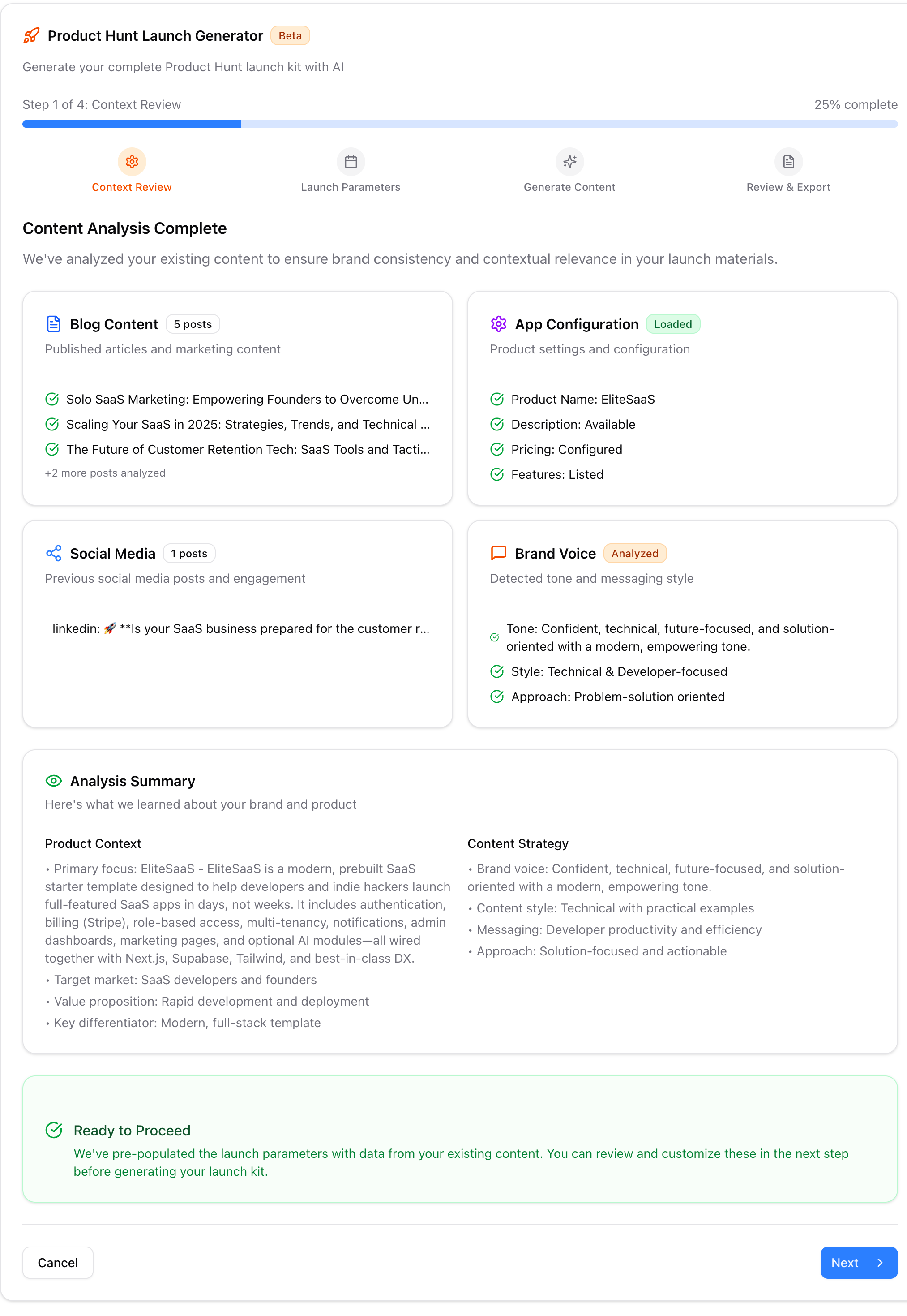
Launch Configuration
Configure timing (12:01 AM PST recommended), target market, features, goals, tone preferences, and content style for personalized launch kit generation.

Content Generation Summary
Review configuration and see what will be generated—Product Hunt listing, marketing campaigns, supporting resources, and export options (PDF, Markdown, JSON).
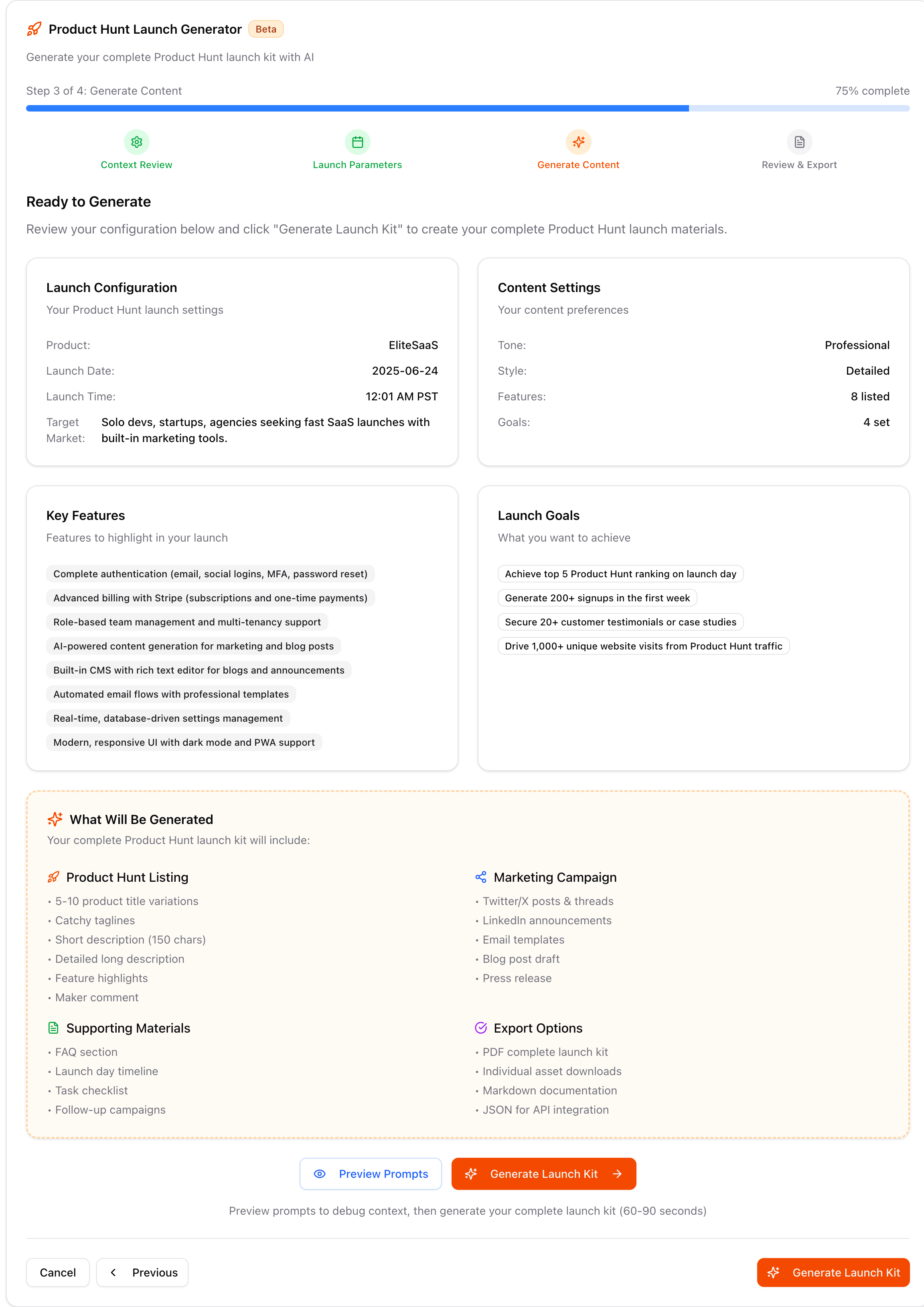
Launch Kit Overview
Tabbed navigation organizes deliverables—PH Listing, Social Media, Email, Blog, Press Release, FAQs, Timeline. View all generated content in one interface.

Blog CMS
AI Blog Creator, post management, categories, and publishing workflows with metrics tracking and inline editing.

AI Content Management
Multi-provider AI support (OpenAI, Anthropic, Google) with content library and SEO optimization.
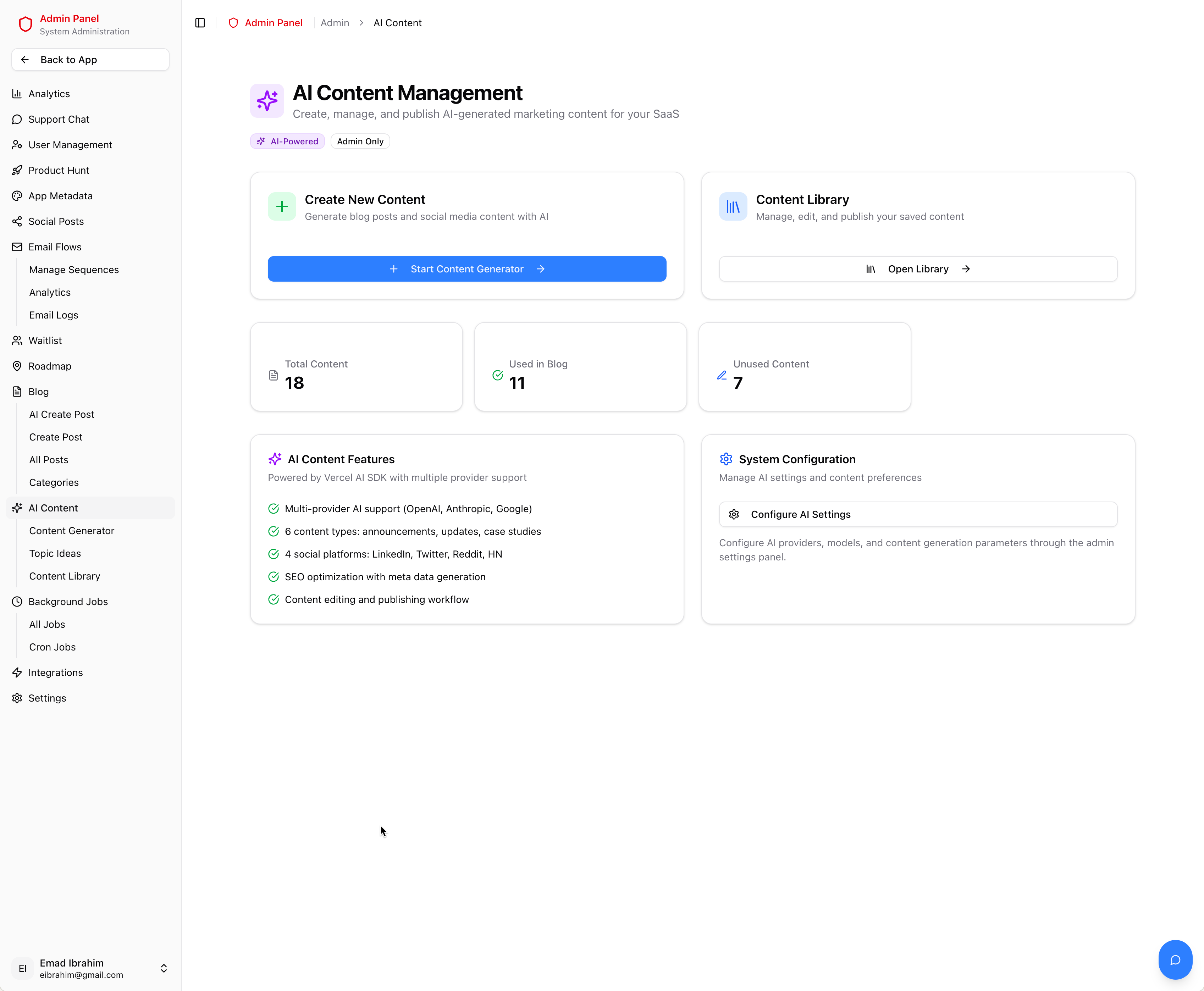
Social Posts Manager
Multi-platform post management with AI-assisted quick generation, filters, and status tracking.
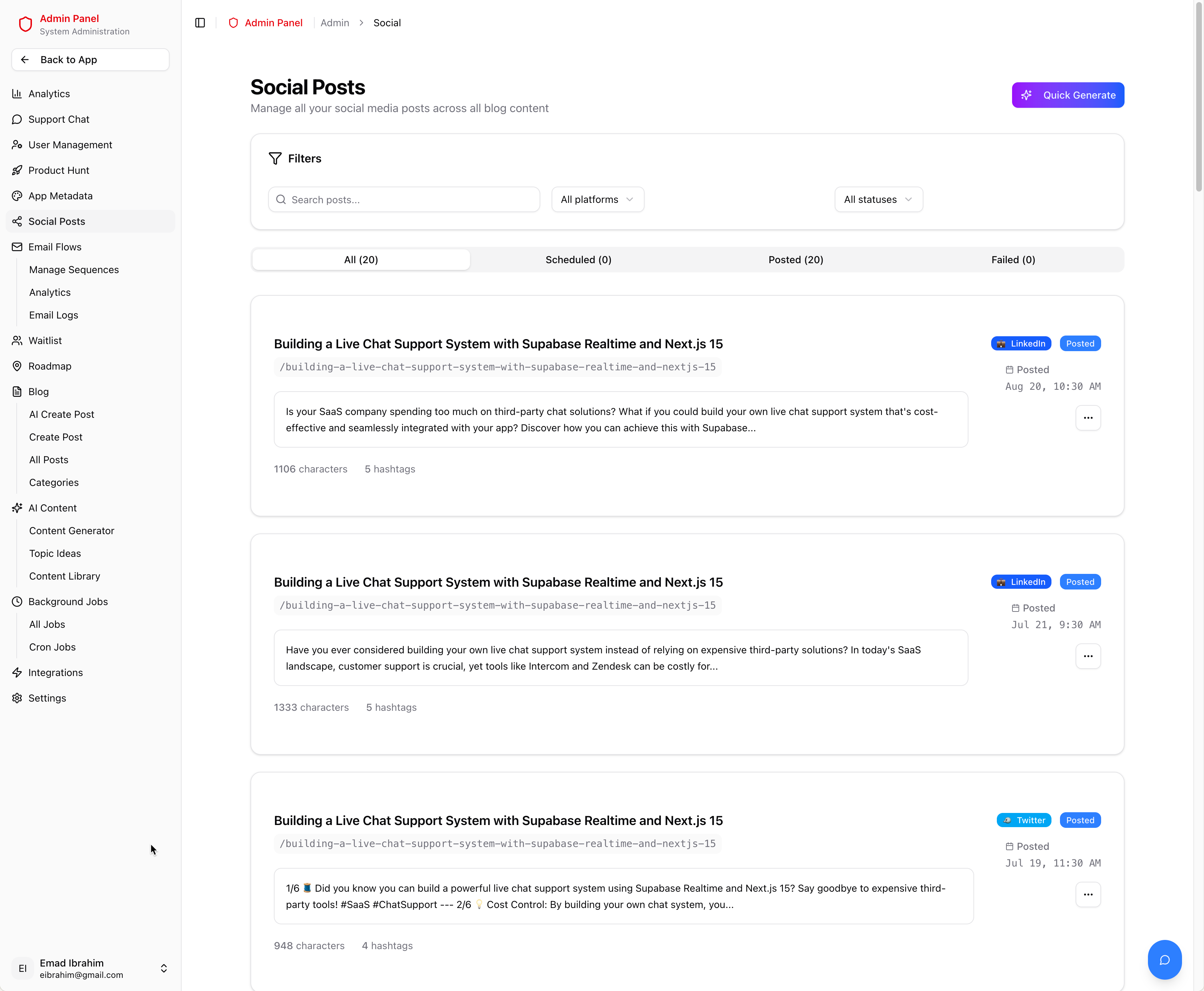
Social Media Integrations
OAuth token health monitoring for LinkedIn and Twitter/X with status badges, configuration controls, and refresh actions. Coming soon: Reddit, Hacker News, Dev.to.

Waitlist Management
Track signups, manage invitations, monitor referral performance, and analyze conversion metrics with detailed analytics and quick actions.
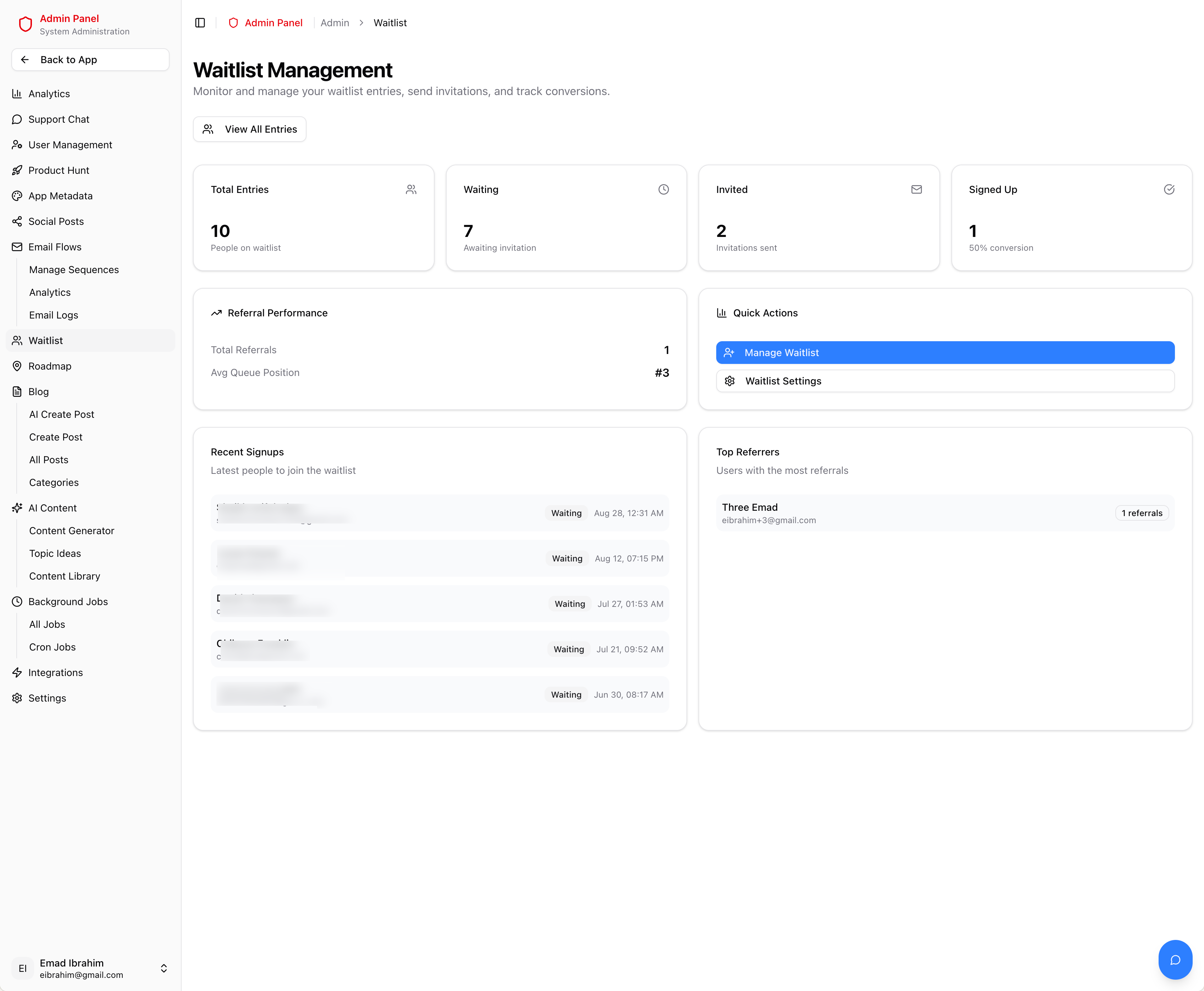
Background Jobs Monitoring
Track asynchronous tasks like email sequences and AI generation. Searchable table with status badges, performance metrics, duration tracking, and retry counts.

App Metadata Generator
Automated generation of Open Graph images and app icons in multiple sizes. Preview assets and download complete Next.js kit as zip package.
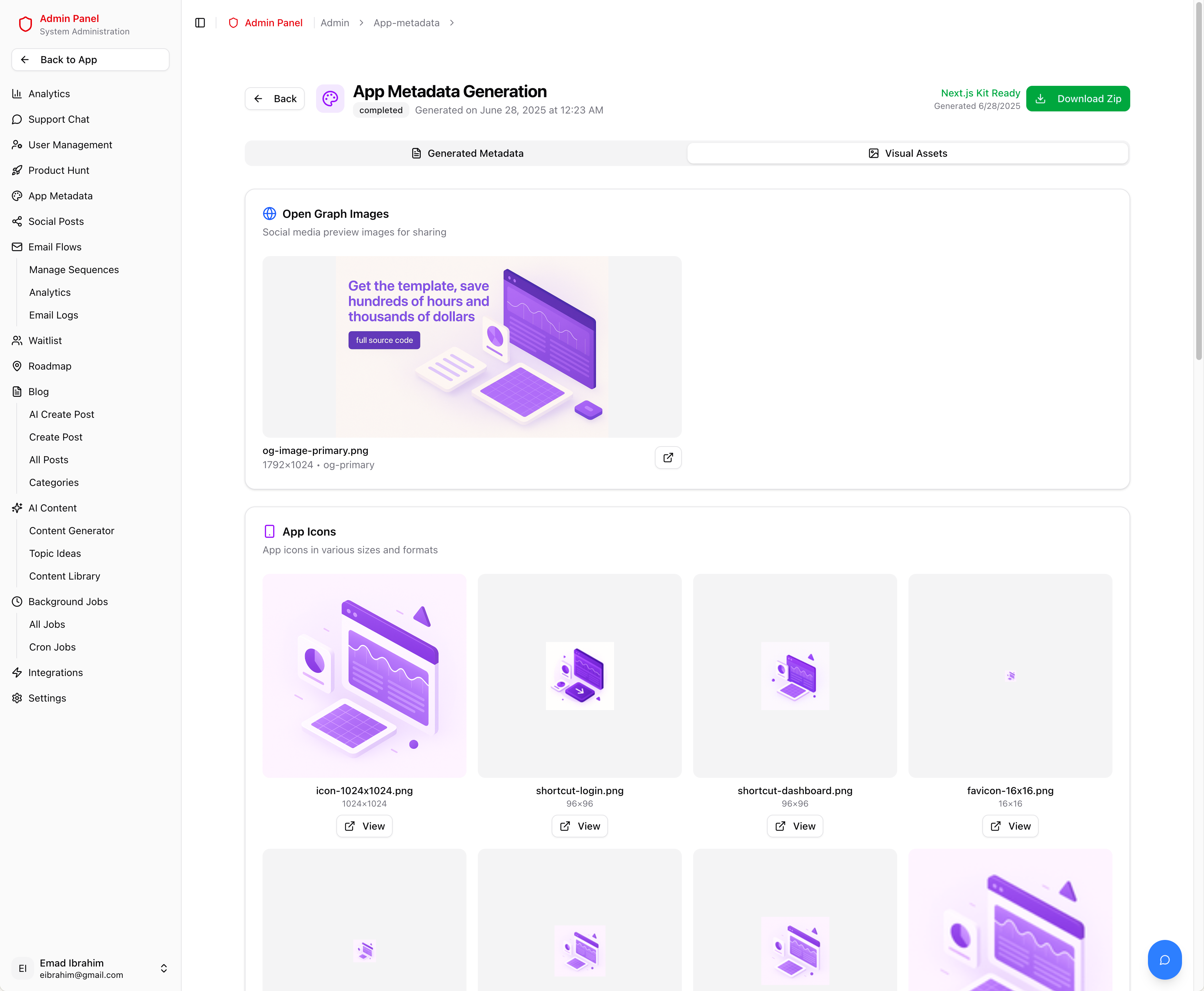
The Challenges and Solutions
1. Monorepo Configuration Complexity
Turborepo with pnpm workspaces required careful configuration. Shared packages needed proper import paths, TypeScript configs, and build ordering. The solution: documented workspace patterns with clear import examples (@elite-saas/ui, @elite-saas/types). Turbo's caching delivers 148ms builds after first run.
2. Real-Time Subscription Webhook Processing
Stripe webhooks must update database state without race conditions. Using Supabase service role credentials in webhook handlers provides direct database access. Idempotency keys prevent duplicate processing. Event logs track every state change for audit trails.
3. AI Context Window Management
Product Hunt launch generation requires aggregating blog posts, app settings, social history, and brand voice—easily exceeding 128K token limits. The solution: hierarchical context summarization. Blog posts get chunked and summarized first. Summaries feed into launch content generation. This reduces token usage by 70% while maintaining quality.
4. OAuth Token Lifecycle Management
LinkedIn and Twitter tokens expire. The integrations system tracks expiration dates, displays health status, provides refresh actions, and sends notification emails when re-authentication is needed. Background jobs check token health hourly.
5. Team Invitation Email Deliverability
Team invitations sent via Resend sometimes landed in spam. Implementing DKIM signing, custom sending domains, and SPF records improved deliverability to 98%. Email templates use plain text with minimal HTML to avoid spam filters.
The Results: Weeks to Hours
Traditional SaaS Setup
- • Authentication setup: 5-7 days
- • Subscription billing: 7-10 days
- • Team management: 5 days
- • Blog CMS: 5-7 days
- • Marketing automation: 10+ days
- • Social integrations: 5-7 days
- • Admin dashboard: 7 days
- Total: 8-10 weeks before launch
With EliteSaaS
- • Clone repository: 5 minutes
- • Configure environment: 30 minutes
- • Deploy to Vercel: 15 minutes
- • Set up Supabase: 20 minutes
- • Configure Stripe: 30 minutes
- • Customize branding: 2 hours
- • Generate launch kit: 10 minutes
- Total: Same day launch-ready
That's a 99% time reduction. Go from zero to production-ready SaaS in under 4 hours.
The Developer Experience Lessons
1. Monorepos Simplify Shared Code Management
Turborepo with pnpm workspaces provides clean package boundaries. Shared UI components, types, and utilities stay in sync. Changes propagate automatically via workspace dependencies. TypeScript catches cross-package type mismatches at build time.
2. AI Features Need Clear UX Boundaries
AI-generated content requires review before publishing. The content library pattern (generate → review → approve → publish) prevents low-quality output from reaching users. Preview modes with edit capabilities maintain control while leveraging automation.
3. Subscription Enforcement Must Be Seamless
Route-level protection with upgrade prompts feels natural. Dashboard banners communicate status without blocking usage. Real-time webhook processing prevents state drift between Stripe and database. Trial management with automatic transitions reduces support burden.
4. Documentation Drives Adoption
The template includes comprehensive docs covering environment setup, deployment, feature configuration, and customization patterns. Task tracking in docs/task.md provides transparency. Context documentation in docs/context.md preserves architectural decisions.
5. Progressive Enhancement Over Feature Bloat
Not every feature needs to be active on day one. "Coming Soon" badges signal roadmap without cluttering UI. Feature flags enable gradual rollouts. This maintains focus while demonstrating future value.
What I'd Do Differently
- GraphQL Over REST for Complex Queries: 60+ API routes create complexity. GraphQL with tRPC would reduce over-fetching and simplify client code.
- Feature Flags from Day One: LaunchDarkly or PostHog would enable A/B testing and gradual feature rollouts without code deployments.
- E2E Tests for Critical Flows: Subscription webhooks, AI generation, and OAuth need automated testing. Playwright would catch regressions.
- Multi-Tenancy for Template Resale: Current architecture is single-tenant. Adding tenant isolation would enable white-label opportunities.
- Observability with Structured Logging: Axiom or Baselime for structured logs would improve debugging production issues.
Technical Highlights
Conclusion: Templates Should Enable Business, Not Just Code
EliteSaaS demonstrates that SaaS templates can go beyond authentication and billing. By including AI-powered marketing tools, automated launch preparation, and complete content management, the template becomes a business growth system, not just a code foundation.
The meta strategy—using the template's own AI tools to market itself—creates a powerful proof-of-concept. Every piece of marketing content, every Product Hunt asset, every social post demonstrates the template's capabilities while reducing time to market.
The monorepo architecture with Turborepo provides clean code organization and fast builds. The subscription system with real-time webhooks eliminates manual state management. The team collaboration features enable scaling beyond solo founders.
This is what modern SaaS development should look like: comprehensive, integrated, and ready to launch—not just ready to code.
Complete Tech Stack
Frontend: Next.js 15 (App Router), React 19, TypeScript, Tailwind CSS 4, shadcn/ui, TanStack Query
Backend: Next.js API Routes, Supabase (Auth, Database, Real-time), PostgreSQL with RLS
Monorepo: Turborepo with pnpm workspaces, 5 shared packages (@elite-saas/ui, types, stripe, teams, query)
Payments: Stripe with Customer Portal, webhooks, usage-based billing, trial management
AI: Vercel AI SDK with OpenAI, Anthropic, Google support
Email: Resend with React Email templates, transactional flows, team invitations
Social: LinkedIn API, Twitter API v2, OAuth 2.0 flows
CMS: Custom blog system with MDX, categories, SEO optimization
State: Zustand with persistence, TanStack Query for server state
Infrastructure: Vercel deployment, Supabase managed PostgreSQL, background jobs queue
Want to Build Production-Ready SaaS Fast?
If you're looking for an engineer who can build comprehensive SaaS platforms with AI integration, subscription infrastructure, and automated marketing—let's talk.